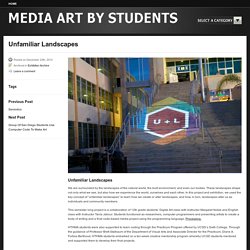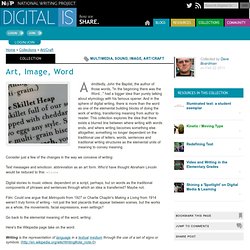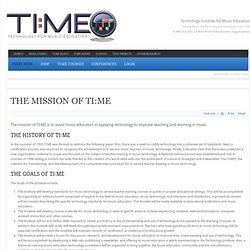

Unfamiliar Landscapes. Unfamiliar Landscapes We are surrounded by the landscapes of the natural world, the built environment, and even our bodies.

These landscapes shape not only what we see, but also how we experience the world, ourselves and each other. In this project and exhibition, we used the key concept of “unfamiliar landscapes” to learn how we create or alter landscapes, and how, in turn, landscapes alter us as individuals and community members. This semester long project is a collaboration of 12th grade students’ Digital Art class with Instructor Margaret Noble and English class with Instructor Tania Jabour. Students functioned as researchers, computer programmers and presenting artists to create a body of writing and a final code-based media project using the programming language, Processing. HTHMA students were also supported to learn coding through the Practicum Program offered by UCSD’s Sixth College.
KPBS TV Feature Story: KPBS Featured Student Projects: “How does sound affect the body?” Unfamiliar Landscapes: Coded Illustrations. Twelfth grade students at High Tech High in San Diego, California created artwork using computer coding for an exhibition entitled “Unfamiliar Landscapes.”

The students chose subjects on which to focus their art which ranged from police brutality to noise pollution to post-traumatic stress. They used computer code—an unfamiliar landscape—as their framework for research inquiry and media art representation. For the first eight weeks of class students studied a programming language called Processing, considering design, color, content and context of their artwork. Using code they were able to change the width and appearance of a stroke, gradually learning more code to represent the subject matter. The series of illustrations featured above show the first landscape sketches of the 12th grade class using a customizable dynamic brush tool. Soundtrap - Make music online. Choreography - Bollywood Vision. Digital Is: When Images Lie. Digital Is: Art, Image, Word. Admittedly, John the Baptist, the author of those words, "In the beginning there was the Word...

" had a bigger idea than purely talking about etymology with his famous opener. And in the sphere of digital writing, there is more than the word as one of the elemental building blocks of doing the work of writing, transferring meaning from author to reader. This collection explores the idea that there exists a blurred line between where writing with words ends, and where writing becomes something else altogether, something no longer dependent on the traditional use of letters, words, sentences and traditional writing structures as the elemental units of meaning to convey meaning. Consider just a few of the changes in the way we conceive of writing: Text messages and emoticon: abbreviation as an art form. Who'd have thought Abraham Lincoln would be reduced to this: =]:-)=
About the Online Digital Book, Flows of Reading. Painting-sharing community, painting the world. Fashioning Technology. News. Pencil - a traditional 2D animation software. Inkscape. Draw Freely. An open drawing project. Trimble SketchUp. Noteflight. TI:ME Technology In Music Education - The Mission of TI:ME. The mission of TI:ME is to assist music educators in applying technology to improve teaching and learning in music.

The History of TI:ME In the summer of 1995 TI:ME was formed to address the following areas: First, there was a need to codify technology into a cohesive set of standards. Next, a certification process was explored to recognize the achievement of in-service music teachers in music technology. Finally, it became clear that there was a need for a new organization, national in scope and focused on the subject of teacher training in music technology.
Computers and Fabrication: Revolutionizing the Art World. It may come as a surprise that one of the four teaching certifications I hold is K-12 Art Education.

It is a certification that I am excited to finally use in my new position in the fall. Throughout high school, I took private art lessons with a local artist. I learned how to mix paint colors, complete paintings with a limited palette, paint with a palette knife, and create drypoint etchings, linoleum prints, mixed media and clay sculpture, as well as how to work in a variety of drawing techniques. For each project we worked on, we also received a lesson in art history, giving us context for the technique or materials we were using. Old School Technology As I reflect on my experiences, I realize that all of these creating and making experiences involved a variety of technologies. Many of these older technologies are still in use in digital fabrication labs (FabLabs) and MakerSpaces around the world. What's Art? Picking Up STEAM So what is the implication for K-12 schools?